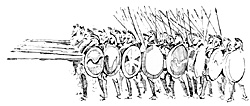 By 675 BC, the principal Hellenic states were employing the tactical formation known as the phalanx. This formation became the backbone of all Hellenic-style armies until the first century
B.C. when the Mediterranean became a Roman lake. Throughout its development and subsequent history, the phalanx remained virtually unchanged, though many variations were used. The
basic armament of a Greek phalanx was the broad-bladed spear (ranging front nine to 12 feet in length) and the round shield (three feet in diameter) called a hoplon. The Macedonians under
whom the phalanx reached its peak of efficiency wore little or no body armor, carried a smaller shield (two feet in diameter} and a longer pike known as a sarissa (thirteen feet long under
Alexander, eighteen feet under his Successors) instead of the Greek-style spear. The general subunit of a phalanx was a block of eight men across by eight men deep -- 64-man squares. The Macedonians doubled this number to form blocks sixteen by sixteen {256-man squares).
By 675 BC, the principal Hellenic states were employing the tactical formation known as the phalanx. This formation became the backbone of all Hellenic-style armies until the first century
B.C. when the Mediterranean became a Roman lake. Throughout its development and subsequent history, the phalanx remained virtually unchanged, though many variations were used. The
basic armament of a Greek phalanx was the broad-bladed spear (ranging front nine to 12 feet in length) and the round shield (three feet in diameter) called a hoplon. The Macedonians under
whom the phalanx reached its peak of efficiency wore little or no body armor, carried a smaller shield (two feet in diameter} and a longer pike known as a sarissa (thirteen feet long under
Alexander, eighteen feet under his Successors) instead of the Greek-style spear. The general subunit of a phalanx was a block of eight men across by eight men deep -- 64-man squares. The Macedonians doubled this number to form blocks sixteen by sixteen {256-man squares).
In any case, the Asian infantryman was (in regard to equipment and organization) decidedly inferior to the Hellenic. The overwhelming Greek victory at Plataea (479 B.C.) was labelled by the poet Aeschylus as the "triumph of the spear over the bow," and though simply stated, this sums up the effect of the Greek system on that of the Persians. The Greek forces, in their close phalanx formation covered by bronze, were capable of achieving much greater momentum in a battle-line. In spite of their heavier armor, the (through extensive training) were accustomed to charging and were virtually missile-proof when facing their opponents. The unshielded line of Persians was a poor match for the heavier Greeks, for victory could only be achiered by close combat, not by missile fire.
More Xenophon
-
Xenophon
Greek Hoplite and Persian Immortal
Timeline: Greco-Persian Wars
Greek Phalanx
Large Map (59K)
Jumbo Map (slow: 127K)
Back to Conflict Number 5 Table of Contents
Back to Conflict List of Issues
Back to MagWeb Master Magazine List
© Copyright 1998 by Dana Lombardy
This article appears in MagWeb (Magazine Web) on the Internet World Wide Web.
Other military history articles and gaming articles are available at http://www.magweb.com